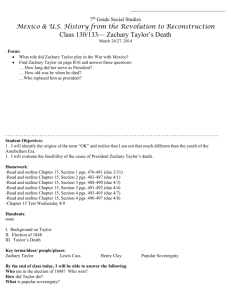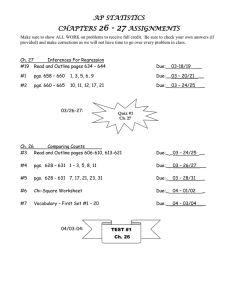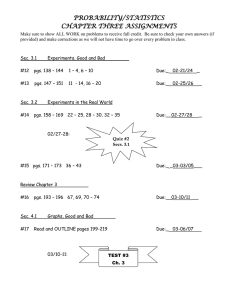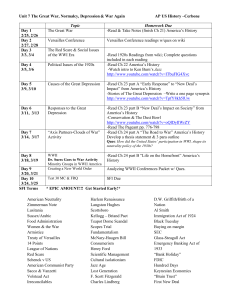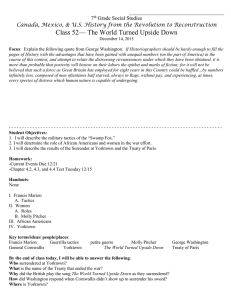Focus: Leave your materials and report to the upstairs computer lab.
advertisement
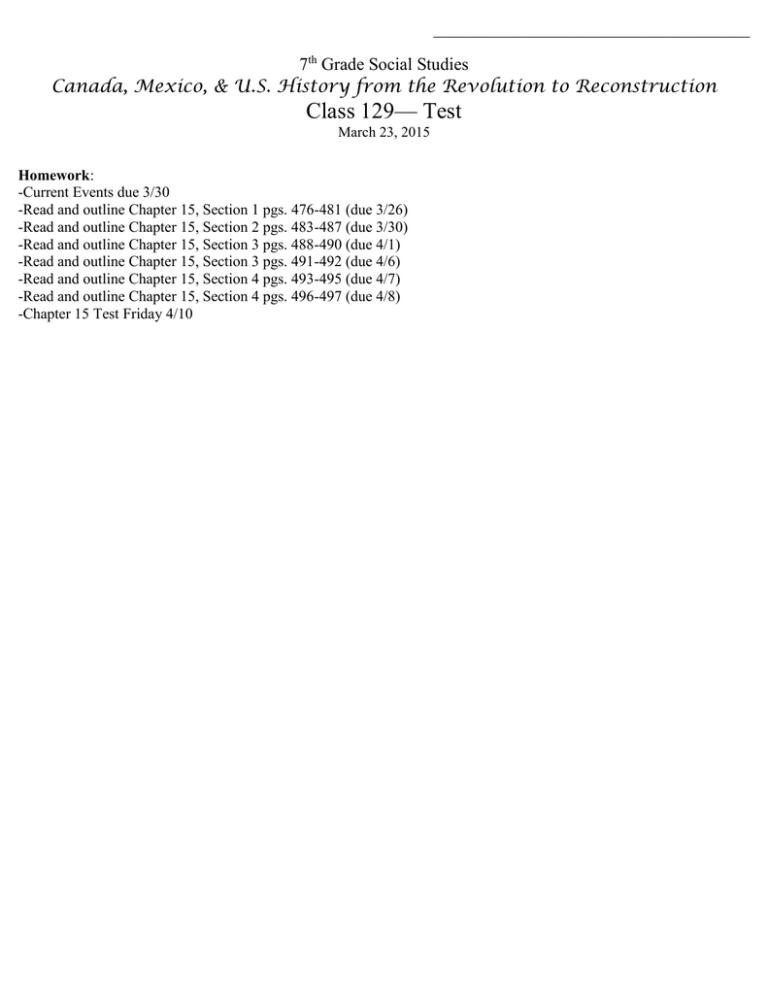
____________________________________ 7th Grade Social Studies Canada, Mexico, & U.S. History from the Revolution to Reconstruction Class 129— Test March 23, 2015 Homework: -Current Events due 3/30 -Read and outline Chapter 15, Section 1 pgs. 476-481 (due 3/26) -Read and outline Chapter 15, Section 2 pgs. 483-487 (due 3/30) -Read and outline Chapter 15, Section 3 pgs. 488-490 (due 4/1) -Read and outline Chapter 15, Section 3 pgs. 491-492 (due 4/6) -Read and outline Chapter 15, Section 4 pgs. 493-495 (due 4/7) -Read and outline Chapter 15, Section 4 pgs. 496-497 (due 4/8) -Chapter 15 Test Friday 4/10 ____________________________________ 7th Grade Social Studies Canada, Mexico, & U.S. History from the Revolution to Reconstruction Class 130— Scheduling & PSSA Prep March 24, 2015 Focus: Leave your materials and report to the upstairs computer lab. --------------------------------------------------------------------------------Student Objectives: 1. I will schedule my 8th grade classes. 2. I will practice for the PSSA reading examination. Homework: -Current Events due 3/30 -Read and outline Chapter 15, Section 1 pgs. 476-481 (due 3/26) -Read and outline Chapter 15, Section 2 pgs. 483-487 (due 3/30) -Read and outline Chapter 15, Section 3 pgs. 488-490 (due 4/1) -Read and outline Chapter 15, Section 3 pgs. 491-492 (due 4/6) -Read and outline Chapter 15, Section 4 pgs. 493-495 (due 4/7) -Read and outline Chapter 15, Section 4 pgs. 496-497 (due 4/8) -Chapter 15 Test Friday 4/10 Handouts: PSSA Reading Prompt-Frederick Douglas I. Scheduling II. Frederick Douglas PSSA Questions Key terms/ideas/ people/places: Frederick Douglas By the end of class today, I will be able to answer the following: When is your scheduling form due? ____________________________________ 7th Grade Social Studies Canada, Mexico, & U.S. History from the Revolution to Reconstruction Class 131— Zachary Taylor’s Death March 25, 2015 . Focus: What role did Zachary Taylor play in the War with Mexico? Find Zachary Taylor on page R16 and answer these questions: … How long did her serve as President? … How old was he when he died? …Who replaced him as president? --------------------------------------------------------------------------------Student Objectives: 1. I will identify the origins of the term “OK” and realize that I am not that much different than the youth of the Antebellum Era. 1. I will evaluate the feasibility of the cause of President Zachary Taylor’s death. Homework: -Current Events due 3/30 -Read and outline Chapter 15, Section 1 pgs. 476-481 (due 3/26) -Read and outline Chapter 15, Section 2 pgs. 483-487 (due 3/30) -Read and outline Chapter 15, Section 3 pgs. 488-490 (due 4/1) -Read and outline Chapter 15, Section 3 pgs. 491-492 (due 4/6) -Read and outline Chapter 15, Section 4 pgs. 493-495 (due 4/7) -Read and outline Chapter 15, Section 4 pgs. 496-497 (due 4/8) -Chapter 15 Test Friday 4/10 Handouts: none I. Background on Taylor II. Election of 1848 III. Taylor’s Death Key terms/ideas/ people/places: Zachary Taylor Lewis Cass Henry Clay By the end of class today, I will be able to answer the following: Who ran in the election of 1848? Who won? How did Taylor die? What is popular sovereignty? Popular Sovereignty Notes Class 131— Zachary Taylor’s Death March 25, 2015 Background on Taylor o Born to Virginia plantation owners o Related to James Madison and Robert E. Lee o Daughter married Jefferson Davis o Grew up in Kentucky o Old Rough and Ready-Indian Fighter Election of 1848: o Crumbling away of second party system o Clay announces his candidacy o Whigs run Taylor, they ran a military hero of a way they had opposed o Democrats run Lewis Cass-believes in popular sovereignty ____________________________________ 7th Grade Social Studies Canada, Mexico, & U.S. History from the Revolution to Reconstruction Class 132— Sectionalism and Compromise March 26, 2015 Focus: What were the three components of the Missouri Compromise? What is the Wilmot Proviso? --------------------------------------------------------------------------------Student Objectives: 1. I will identify the difference between a “Free Soiler” and an abolitionist. 2. I will recall the impact of the Missouri Compromise of 1820 in the controversy over slavery. 3. I will re-enact a sectional dispute between Henry S. Foote and Thomas Hart Benton on the Senate floor. 4. I will describe how the Compromise of 1850 affected the slavery issue. Homework: -Current Events due 3/30 -Read and outline Chapter 15, Section 2 pgs. 483-487 (due 3/30) -Read and outline Chapter 15, Section 3 pgs. 488-490 (due 4/1) -Read and outline Chapter 15, Section 3 pgs. 491-492 (due 4/6) -Read and outline Chapter 15, Section 4 pgs. 493-495 (due 4/7) -Read and outline Chapter 15, Section 4 pgs. 496-497 (due 4/8) -Chapter 15 Test Friday 4/10 Handouts: none I. Free-Soilers II. Missouri Compromise III. Foote VS. Benton IV. Compromise of 1850 Key terms/ideas/ people/places: Free-Soiler Abolitionist Henry Clay Missouri Compromise David Wilmot Wilmot Proviso Zachary Taylor Millard Fillmore Popular Sovereignty Henry S. Foote Thomas Hart Benton Great Compromiser Compromise of 1850 Stephen Douglas Omnibus Bill Fugitive Slave Law Henry Clay By the end of class today, I will be able to answer the following: What were the three components of the Missouri Compromise? What was the Wilmot Proviso? How did it contribute to Sectionalism? What were the five components of the Compromise of 1850? Who was the Great Compromiser? Why did he get this name? Notes Class 132— Sectionalism and Compromise March 26, 2015 Free Soilers: stop all African Americans from the territories whether they were free or slave Northern whites did not want to share the territories with slaveholders or with slaves-“did not want to compete with slave labor or to permit any further extension of the political power of planters.” they would never interfere with slavery in the states greatly outnumbered the abolitionists in the North Abolitionists: ban slavery only 10% of the population Missouri Compromise: Maine Free state Missouri Slave state Slavery below the 36 degree 30’ line Wilmot Proviso: outlawing slavery in the territories Wilmot doesn’t want whites to compete with African Americans for jobs Election of 1848: Whigs-Zachary Taylor Democrats-Lewis Cass Free Soilers-Martin Van Buren Popular Sovereignty-people decide if a state would have slavery or not Compromise of 1850: California enters as free state Popular sovereignty would determine slave or free state in the Mexican Cession Slave trade banned in D.C.-gives foreigners a bad perception of the nation Stricter fugitive slave law Boarder dispute between TX and NM solved-Gov’t helps pay Mexican debts Henry Clay-Great Compromiser fugitive slave act All citizens had to participate in catching slaves Fined $1,000 or jailed for 6 months if helped runaway Special Courts-$10 for sending slave back-$5 for setting one free Northerners feel they are part of the slave system-the federal government had gone into the business of manhunting and required freeborn Americans to become man-hunters on occasion Far more than a law to overtake slaves that were running away but also a device to recover slaves that ran away in the past
